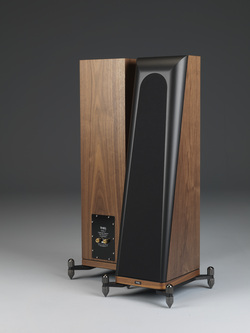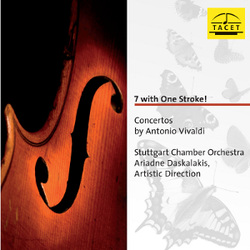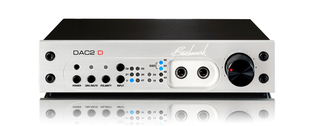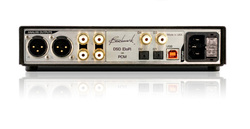 (Lexington, KY) April 29th, 2013 -- THIEL Audio (www.thielaudio.com) has announced the introduction of the CS1.7 Coherent Source® floorstanding loudspeaker. The CS1.7 employs THIEL’s renowned phase and time coherent design using precision engineered first order acoustic crossover networks and the latest technology for the woofer and tweeter engineered by THIEL specifically for the CS1.7 project. The CS1.7s follow a long tradition of THIEL 2-way floorstanding speakers beginning with the Model 04 in 1979. Each new iteration of this series from THIEL has received accolades from audiophile journalists and music lovers worldwide. The CS1.7 seeks to establish new standards for resolution of detail, imaging and staging, dynamic capability, and tonal purity for those consumers seeking ultra high fidelity from an attractive, compact form factor. The technology employed in the CS1.7 design is all new, leveraging much of the R&D from the flagship model CS3.7. The CS1.7 tweeter, based on the platform used in the enormously popular CS1.6 has been highly optimized for the CS1.7 featuring a new voice coil, new magnetic circuit and reworked aluminum diaphragm resulting in increased linearity and lower distortion. The aluminum woofer’s “star” diaphragm was conceived using the latest laser measurement technology and also utilizes a new voice coil and magnetic structure that enables the driver to operate as a piston through a much greater range of frequencies. The crossover network is a classic THIEL first order acoustic design, maintaining the phase and time coherent nature of all THIEL loudspeakers. The cabinet is 1-inch thick and the massive baffle, with a low turbulence vertical port, is 2-inches thick, delivering the ultimate in rigidity and inertness. Even the magnetically adhered grill has been carefully engineered to prevent any diffraction. The CS1.7 comes equipped with leveling feet, however an optional brushed aluminum Outrigger base (pictured here) is available to improve the sonic performance of the speaker by maximizing stability on virtually any surface. “The CS1.7 delivers superb musicality from a sleek floorstanding loudspeaker that is décor friendly thanks to its moderate size and elegant array of real wood veneers,” said THIEL National Sales Manager Stephen DeFuria. The CS1.7 represents the performance and value that our dealers and worldwide distribution have been asking for.” The THIEL CS1.7 is now shipping to authorized THIEL dealers with an MSRP of $3999 per pair. CS1.7 Dimensions Size Inches: (W x D x H) 9.5 x 11.8 x 36.5 (with outriggers 13.8 x 15 x 38.5) Size Centimeters: (W x D x H) 24 x 30 x 92.4 (with outriggers 350 x 380 x 97.7) Weight: 54 lbs / 23 kgs  7 with One Stroke! Concertos by Antonio Vivaldi Stuttgart Chamber Orchestra Ariadne Daskalakis, Artistic Direction CD (total playing time: 60'09) Order no. TACET 205-0 Barcode 40 09850 020509 The Stuttgart Chamber Orchestra is not made up exclusively of orphan boys - quite the contrary! On this CD, the "Schwabenstreicher" (Swabian string players), as they like to refer to themselves, take on the roles of the orphan girls taught by Antonio Vivaldi and for whom he wrote countless concertos. In the supplementary text, Thomas Seedorf reports that the schoolgirls were all so eager to learn that they could take on whatever solo parts they liked. And because the present-day orphan girls - led by Ariadne Daskalakis - were so full of energy, they took care of seven pieces at once - in one go, as the title gives away. We wish you much enjoyment listening to all of these various impulses, personal timbres and effervescent interpretative ideas!  The DAC2 D is a digital reference DAC without the analog inputs. Performance The DAC2 D has the same performance of the DAC2 HGC but without the analog inputs and the 12V trigger. Keeping the specs inline with DAC2 D, it has lower noise, lower distortion, improved accuracy, outstanding musical detail, precise stereo imaging, an advanced digital filter design, and a new high-sample-rate Asynchronous USB Audio interface. All inputs are fully isolated from interface jitter by Benchmark's new UltraLock2™ jitter attenuation system. Internal digital processing and conversion is 32-bits, and includes 3.5 dB of headroom above 0 dBFS. Four balanced 32-bit D/A converter are summed together for each balanced output. The performance of the DAC2 D exceeds the measurement limits of today's state-of-the art test equipment. Discover the analog sound of the DAC2 D.
Hybrid Gain Control The DAC2 D combines active analog gain control, passive low-impedance attenuators, a 32-bit digital gain control, and a servo-driven volume control. All inputs are controlled by the rotary volume control. This volume control moves in response to commands from the remote control. Digital inputs never pass through an analog potentiometer. Digital inputs are precisely controlled in the 32-bit DSP system. The DSP system preserves precise L/R balance, and precise stereo imaging, while avoiding any source of noise and distortion. Benchmark's unique passive output attenuators provide distortion-free gain reduction without reducing the dynamic range of the converter. The attenuators optimize the gain staging between the DAC2 D and the power amplifier. This optimization is absolutely essential for maximizing the dynamic range of the entire playback system. Much of the success of the DAC1 converters can be attributed to the passive output attenuators. Musical details can be obscured by system noise whenever a preamplifier and power amplifier are improperly matched. The" HGC " system will make full use of your power amplifier's dynamic range. Experience new details in your favorite recordings.  Native DSD Conversion All digital inputs on the DAC2 D support native DSD conversion. DoP 1.0 is automatically detected on all digital inputs, and the system seamlessly switches to native DSD conversion. DoP 1.0 is supported by many media players, and DSD downloads are now available from several sources. UltraLock2™ Jitter Attenuation System UltraLock2™ is an improved version of the UltraLock™ system used in the DAC1 and ADC1 product families. DSP processing is 32-bits, DSP headroom is 3.5 dB, sample rate is 211 kHz, and jitter-induced distortion and noise is at least 140 dB below the level of the music - well below the threshold of hearing. Benchmark's UltraLock2™ system eliminates all audible jitter artifacts. High Headroom DSP - with 3.5 dB "Excess" Digital Headroom. All of the digital processing in the DAC2 D is designed to handle signals as high as +3.5 dBFS. Most digital systems clip signals that exceed 0 dBFS. The 0 dBFS limitation seems reasonable, as 0 dBFS is the highest sinusoidal signal level that can be represented in a digital system. However, a detailed investigation of the mathematics of PCM digital systems will reveal that inter-sample peaks may reach levels slightly higher than +3 dBFS while individual samples never exceed 0 dBFS. These inter-sample overs are common in commercial releases, and are of no consequence in a PCM system until they reach an interpolation process. But, for a variety of reasons, virtually all audio D/A converters use an interpolation process. The interpolation process is absolutely necessary to achieve 24-bit state-of-the art conversion performance. Unfortunately, inter-sample overs cause clipping in most interpolators. This clipping produces distortion products that are non-harmonic and non-musical. We believe these broadband distortion products often add a harshness or false high-frequency sparkle to digital reproduction. The DAC2 D avoids these problems by maintaining at least 3.5 dB of headroom in the entire conversion system. We believe this added headroom is a groundbreaking improvement. Multi-Mode Asynchronous USB System Benchmark's USB system supports USB Audio 2.0, DSD, and USB Audio 1.1. It is frequency agile, and will follow sample rate changes initiated by the computer and/or the media playback software. In all modes the USB communications are asynchronous in order to eliminate unnecessary sources of jitter. The DAC2 D has a low-jitter master clock which controls the transfer of audio data from the computer to the USB sub-system. The computer asynchronously transfers audio data to a buffer in the DAC2 D. The contents of the buffer are then asynchronously transferred to the D/A conversion sub-system. This second asynchronous transfer eliminates any traces of jitter that accumulate as the data is transferred between the USB and conversion subsystems. No traces of jitter-induced distortion are measurable to our measurement limits (better than -150 dBFS). This truly represents the state-of-the art. Enjoy the convenience of computer playback without compromise. The Asynchronous USB system supports USB Audio 2.0 for high-resolution 192kHz, and DSD playback. No drivers are required for MAC operating systems. An easy-to-install driver adds 192 kHz and DSD capabilities to Windows operating systems. An asynchronous, driverless USB Audio 1.1 mode supports sample rates up to 96 kHz. This USB mode can be selected from the front panel or from the remote control. The driverless USB Audio 1.1 mode allows quick plug-and-play connections to Windows, MAC, iOS, and Linux operating systems without installing drivers. Just plug in the USB, and the DAC2 D becomes an available audio device. The USB subsystem remains active when the DAC2 D is powered down. This prevents interruptions to the computer playback operations and eliminates the need to reconfigure the computer every time the converter is turned on. Quad 32-bit Balanced Conversion System Four balanced 32-bit D/A converters deliver audio to Benchmark's low-impedance current to voltage converters. The 4:1 redundancy reduces noise and distortion to levels that set new benchmarks. The conversion system at the core of the DAC2 D is as good as it gets. The analog circuits that follow the D/A converter are carefully designed. Benchmark has leveraged its long history of building high-end analog audio equipment, in order to create an outstanding output stage. Diagnostic Tools - Sample-Rate and Word-Length Indicators Ever wonder why that 192 kHz 24-bit download on your computer just doesn't sound right? Your media player may be down-sampling to 44.1 kHz and/or truncating to 16-bits. Many media players apply poor-quality sample rate conversion and truncation. Fortunately these problems can be eliminated with the selection a good frequency-agile media player. The sample-rate and word-length displays on the DAC2 D confirm the proper operation of your media player. Polarity Switch You may encounter recordings with inverted polarity. The DAC2 D includes a polarity switch to correct the problem. Home Theater Bypass The DAC2 D can be integrated into a home theater system. Typically the DAC2 D drives the left and right power amplifiers. A programmable Home Theater Bypass function sets the pass-through gain to unity when the surround system is active. The DAC2 D includes an indicator light that is illuminated when bypass is active. Digital Pass Through The second coaxial input can be reconfigured as a digital output. In output mode, any selected digital input (including USB) will pass through to the coaxial output. The digital pass through is bit-transparent and even supports DSD (DoP 1.0). Dolby digital and DTS formats can be passed through to a surround processor. Power Switch The power switch can place the DAC2 D in standby, or full shut down. Power consumption is less than 0.5 W in full shut down. Low Power Consumption The DAC2 uses high-efficiency low noise power supplies and may be operated from any standard international voltage without adjustment. Power consumption is 12 W typical. Distributed Power Regulation To achieve the lowest possible noise, the DAC2 D uses distributed power supply regulation. Each critical subsystem has at least one dedicated low-noise voltage regulator. |
Archives
October 2016
|

 RSS Feed
RSS Feed


